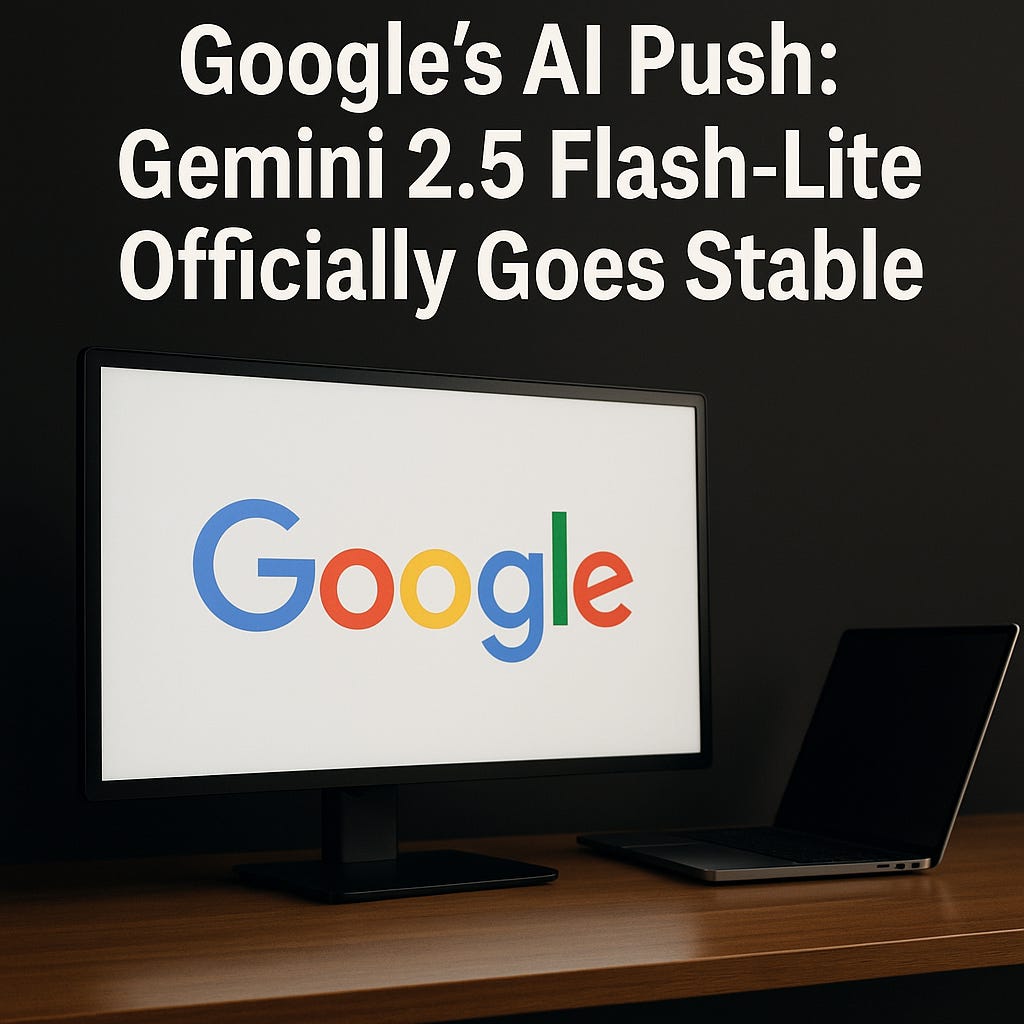Google’s AI Push: Gemini 2.5 Flash-Lite Officially Goes Stable
A million-token memory, ultra-low pricing, and switchable reasoning make Google’s leanest AI model its most accessible yet.
By Karan Bir Singh Sidhu, IAS (Retd)
Former Special Chief Secretary, Punjab. Gold Medallist in Electronics and Communications Engineering .Writes on the intersection of artificial intelligence, emerging AI products, global tech trends, and their implications for India’s strategic and socio-economic landscape.
Gemini 2.5 Flash-Lite Officially Goes Live
On 22 July 2025, Google released the stable, general-availability version of Gemini 2.5 Flash-Lite, the latest addition to its Gemini family of large language models. Touted as the most cost-efficient offering yet in Google’s AI lineup, Flash-Lite is designed to deliver high-speed, high-volume performance at ultra-low prices. This model is now available in the Gemini API, Google AI Studio, and Vertex AI, and it replaces the earlier preview version.
With pricing set at just US $0.10 per million input tokens and $0.40 per million output tokens, Flash-Lite is not only significantly cheaper than its predecessors but also engineered to handle massive volumes of text with minimal delay. It’s built for tasks like live translation, summarising long documents, and handling fast-paced conversational AI. Developers can even choose between a “non-thinking” fast mode or engage “thinking budgets” for more complex reasoning.
What’s a Token, and Why Does It Matter?
Before diving deeper, it’s worth clarifying a term that appears frequently in discussions about large language models: the token. In simple terms, a token is a small chunk of text—often a word, part of a word, or even a single punctuation mark. A good rule of thumb is that one token equals about four characters, or roughly three-quarters of a word in English.
Why does this matter? Because AI models process everything—your questions, documents, and their own replies—in tokens. Every prompt you send and every word the model generates is counted and billed in tokens. That means pricing (like Flash-Lite’s 10 cents per million input tokens) directly determines how affordable large-scale AI use can be. Also, a model’s context window—the number of tokens it can hold in memory at once—defines how much information it can understand in a single go. In Flash-Lite’s case, a one-million-token window means it can process the equivalent of 750,000 words at once, enough to digest an entire book, codebase, or a year’s worth of emails without breaking it into pieces.
What’s New in Gemini 2.5 Flash-Lite
Flash-Lite carries forward some of the strongest features from its siblings. It can process multimodal inputs (text, images, video, audio, PDFs), supports native tools like Google Search, code execution and URL-based grounding, and introduces a 1 million-token context window—a huge jump from earlier models. Most importantly, it enables developers to toggle "thinking budgets," a feature that lets the model take its time on complex questions without defaulting to full-blown reasoning for every minor task.
Compared to Google’s earlier 2.0 Flash-Lite model, the 2.5 version is faster, more memory-efficient, and significantly cheaper. It even maintains surprisingly strong reasoning abilities. For example, on Google’s internal benchmarks, Flash-Lite’s “thinking” mode scores 63.1% on AIME 2025 Math problems, up from 29.7% in the previous version.
Strategic Position Within Google’s Ecosystem
Flash-Lite is the lightest member of the Gemini 2.5 family, which also includes Gemini 2.5 Flash and the top-tier Gemini 2.5 Pro. Flash-Lite trades off a bit of raw intelligence for lightning-fast performance and minimal cost, making it ideal for enterprise-scale workloads like translation pipelines, customer support bots, and content summarisation tools. Its low cost opens the door for startups to experiment with AI affordably, while big enterprises can integrate it into existing Vertex AI platforms for high-throughput tasks.
How It Stacks Up Against Rivals
In a crowded market, Gemini 2.5 Flash-Lite positions itself impressively. It undercuts OpenAI’s GPT-4o “Mini” (rumoured at $0.20 per million input tokens) and beats both Claude-Haiku-2 by Anthropic and Mistral-Small-Lite in terms of context length. Importantly, it does so while integrating directly with Google’s tool ecosystem and offering enterprise-grade data compliance.
Competitors like Elon Musk’s xAI have taken a different route. Their flagship, Grok 4, is part of a premium subscription model (reportedly around $300/month for SuperGrok Heavy), offering shorter context lengths but pitched as fast, uncensored, and highly conversational. Meanwhile, Perplexity AI is embedding its models directly into web experiences, leveraging a browser-like interface and real-time search, with token pricing around $1 per million.
Google’s approach, in contrast, marries deep infrastructure integration with a strategy of pricing LLM access like a utility—affordable and scalable, not elite and exclusive.
Implications for India
For a country like India, where language diversity, population scale, and cost-sensitivity all converge, Flash-Lite’s arrival is momentous. With support for 1 million tokens, entire legislative Acts, court judgments, or multilingual health records can be processed in one sweep—particularly useful in public sector workflows or legal-tech innovation. Sub-cent token costs mean AI-powered services like real-time customer assistance, document translation, and medical diagnostics can reach small businesses and state-run platforms alike.
Moreover, Flash-Lite’s presence in the Google Cloud Mumbai region ensures data residency compliance, a major concern for Indian regulators. It also provides a stepping-stone for local startups to build AI-native apps without burning capital on experimentation. This kind of infrastructure democratisation could empower the next wave of Indian AI development across sectors.
The Road Ahead
With Gemini 2.5 Flash-Lite now stable, Google has positioned itself to drive large-scale AI adoption across industries and geographies. Upcoming features like Deep Think Mode and Agent Mode—targeted at analytical work and browser-based automation—could further enhance its utility, especially as more business workflows shift toward semi-autonomous agents. Flash-Lite may not carry the raw intelligence of Pro or the flair of Grok, but in terms of sheer usability and accessibility, it could well become the standard AI workhorse of 2025.


